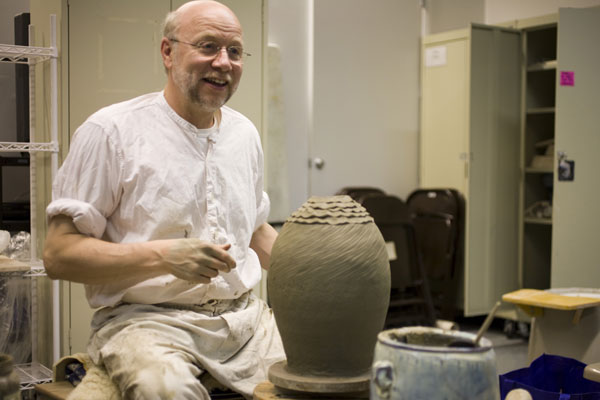“Stoked: Five Artists of Fire and Clay,” a ceramics exhibit showcasing 80 works by renowned Minnesota potter Richard Bresnahan and four of his former apprentices, can be seen from Sept. 14 to Jan. 10 on the St. Paul campus of the University of St. Thomas.
The exhibit, free and open to the public, will be displayed in the lobby gallery of O’Shaughnessy Educational Center. The hours are 9 a.m. to 10 p.m. Monday through Saturday, and noon to 9 p.m. on Sunday.
St. Thomas is the sixth stop on the exhibit’s national tour.
A lecture and opening reception will be held at 6:30 p.m. Thursday, Oct. 4, in the O’Shaughnessy Educational Center auditorium and lobby. The speaker will be Dr. Matthew Welch, deputy director and chief curator of the Minneapolis Institute of Arts and curator of the “Stoked” ceramics exhibit.
After graduating from St. John’s University in Collegeville in 1976, Bresnahan served as an apprentice for three years under Nakazato Takashi in Karatsu, Japan. His training included everything from menial housekeeping tasks to throwing 500 pieces of pottery in a single day.
Critical to his training was learning about local clays and how to make and apply glazes made from ash and plant materials. Today, he and his apprentices typically use materials found in the Collegeville area.
Bresnahan returned to St. John’s University in 1979 as its first non-monastic artist in residence and created on campus a pottery studio and wood-fired kiln. Over the years he has experimented with new forms, glazes and techniques, and since the late 1980s, he has taken on about 45 apprentices.

Dr. Mathew Welch, author of "Stoked: Five Artists of Fire and Clay," and the book's editor, Sandra Lipschultz.
Welch, the exhibit’s curator, selected works from Bresnahan and representatives from four generations of his apprentices. They are: Kevin Flicker, ceramics instructor at the University of Minnesota-Morris; Stephen Earp, ceramicist and writer from Shelburne Falls, Mass.; Samuel Johnson, ceramics instructor at the College of St. Benedict and St. John’s University; and Anne Meyer, ceramicist and sculptor from St. Joseph. While their works reflect different creative approaches, they share a common concern for indigenous materials in relationship to the environment.
“An abiding respect for ecology and natural systems has always characterized Richard Bresnahan’s philosophy and his ongoing dialogue with fire and clay,” wrote Welch. “Throughout his long career, he has consistently challenged himself to undertake new firing techniques, to test potential glaze materials, and to devise unique and elegant functional forms. As a result, the dynamic pottery Bresnahan creates reflects both the specifics of his physical environment – by utilizing local resources – and his own far-reaching artistic vision.”
Each of the four apprentices add their own interpretation to the techniques they learned under Bresnahan. Whether incorporating or building on his philosophy, the apprentices have clearly adopted Bresnahan’s approach.
“ … each maker is ‘stoked’ in the best sense of the word – excited about life and the simple act of using the earth and fire to produce objects of great mystery and strength,” Welch wrote.
“Stoked: Five Artists of Fire and Clay” is paired with a catalog written by Welch. It contains nearly 90 color photographs of the works in the exhibit and biographical reviews of the five artists. The book will be available for purchase and autographing at the opening reception.
The exhibit at St. Thomas is hosted by the university’s Art History Department, part of the College of Arts and Sciences. The Oct. 4 lecture and reception is co-sponsored by the St. Thomas Alumni Association. Information about the exhibit can be found online or by calling (651) 962-5560.
Those attending the lecture and reception are asked to pre-register at this website.








